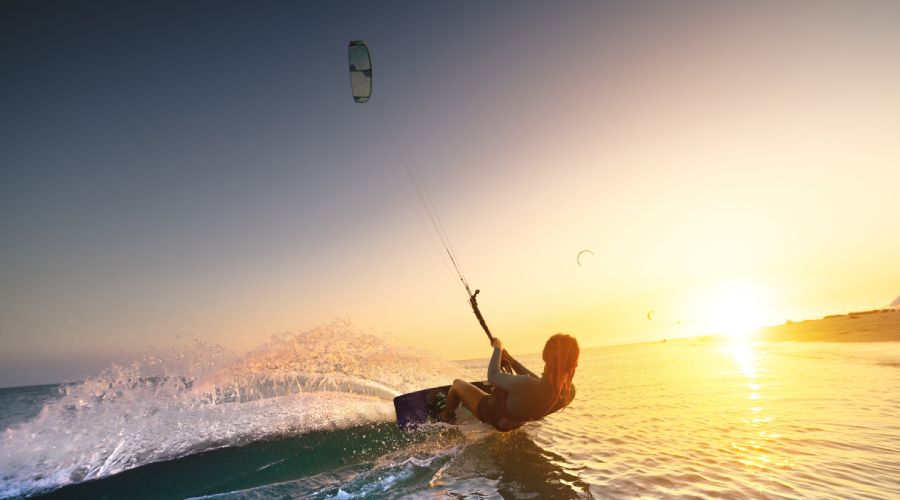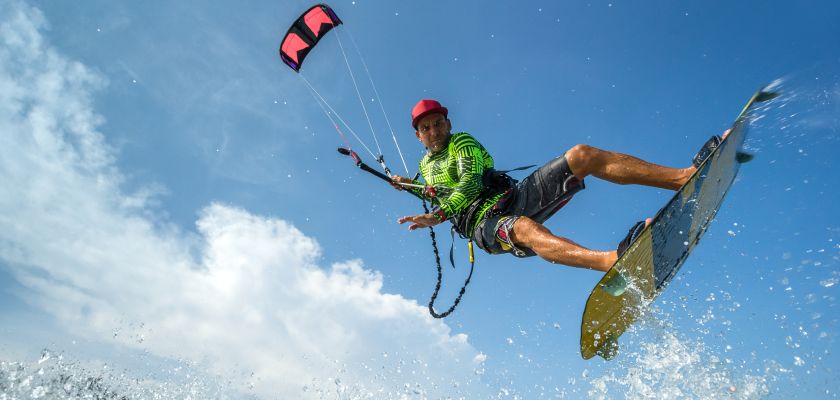Knowing everything about Kitesurfing is the first step for those who are thinking of buying a board, a “kite” and floating around the most crystalline waters in the world! rs Is this your case?
Well, who wouldn’t want to travel the world to enjoy the most beautiful beaches, right?
But if that’s not your plan, no problem, don’t be intimidated, because our aim here is to gather the most important information about kitesurfing, for everyone who is curious about the sport;
After all, kitesurfing is a water sport that combines aspects of surfing, windsurfing and paragliding;
However, at the same time, there is a list of characteristics that differentiate the sport from other sports. So what is kitesurfing in the end? lol
A unique category, no doubt about it!
For example, unlike surfing, kiting doesn’t require waves. After all, the element responsible for the athlete’s movement over the water is the wind, which pushes the “kite”, which in turn is tied to the kitesurfer’s waist;
Another difference, this time in relation to windsurfing, is the fact that in kiting, the accessory responsible for using the force of the wind in the athlete’s favor is not a sail, but a type of kite (which looks more like a parachute, in fact);
These are just a few features of the sport that has been gaining the attention of many water lovers.
So, let’s understand in more detail everything about kitesurfing, a sport that can be highly competitive or just used as a fun activity to practice!
Participate in our free WhatsApp community and receive daily tips, news and trivia on more than 50 sports! Click here to join.
All about kitesurfing: what is it?
Kitesurfing is a water sport in which the athlete uses a type of kite, known as a kite, attached to the waist and a surfboard model, used to glide over the water. The wind hits the kite and moves the athlete, who controls the direction by means of a bar.
In other words, kitesurfing uses the force of the wind that touches the kite to propel the athlete over the water.
So you don’t need a wave to be able to practice the activity. Just good equipment and, of course, wind.
During the activity, the kitesurfer stands on the board, attaches the kite to their waist and holds the control bar, with which they will make the movements and indicate the direction and speed.

Types of kite
Since 2006 there has been a big change in the design of kitesurfing kites. This is because there used to be only one type of kite, the C-kite;
However, in 2006 bow or SLE kites were introduced to the market. In other words, new kite models emerged and began to be incorporated into the sport;
Today, C kites are still used by more experienced athletes due to their quick reaction, but new athletes are preferring the latest models.
Kitesurfing rules
One of the most important steps in the process of understanding everything about kitesurfing involves knowing the rules of the sport, most of which are related to safety.
- Kitesurfers must respect other kitesurfers, water sports enthusiasts (such as canoeing) and bathers.
- It is essential to keep a safe distance and avoid dangerous maneuvers near other people.
- Before starting, it’s important to check the weather and sea conditions. Make sure they are suitable for your skill level.
- Kitesurfers should practice the activity in designated areas suitable for the sport.
- When two kitesurfers are approaching each other from opposite directions, the kitesurfer who has the wind blowing from the left side of their body has the right of way.
- Kitesurfers who are just starting out in the sport should give priority to more experienced kitesurfers. This includes giving up space and avoiding interfering with other riders’ maneuvers.
- Use appropriate visual cues, such as hand gestures or light signals, to communicate your intentions to other kitesurfers;
Following these basic rules helps to ensure that everyone can enjoy kitesurfing safely and responsibly, while maintaining an atmosphere of respect and cooperation between riders.
Also read: Rules of Windsurfing: how the Olympic sport is practiced and tips for those who want to watch it
How to navigate?
The kitesurfer enters the water with the kite already assembled and inflated. Once in the water, they place the control bar in the correct position and assume a starting position on the board.
To take off, the kitesurfer extends his arms, pulling the control bar up and back. This causes the kite to gain height and catch the wind, pulling the kitesurfer along.
With the kite in the air, the athlete uses the control bar to navigate, turning the kite left or right to change direction;
The power generated by the kite can be adjusted by the kitesurfer by pulling or releasing the control bar.
All about kitesurfing: we answer the most frequently asked questions
How does Kitesurfing work?
In kitesurfing, the athlete uses the kite to catch the wind and be pulled over the water while on a board. They manipulate the direction and power of the kite using the control bar, which allows them to navigate, perform maneuvers and even jump over the waves.
Important equipment for kitesurfing
Of course, some equipment is essential for kitesurfing:
- Kite: Varies in size and style, designed to catch the wind and pull the kitesurfer over the water.
- Barra de control: Allows the kitesurfer to control the direction and speed of the kite.Prancha: Specially designed for kitesurfing, offering wind and manoeuvrability.Ranch: Designed specifically for kitesurfing, offering buoyancy and manoeuvrability.Neoprene suit: Protects the kitesurfer’s body from the cold and provides additional buoyancy.Harness: Connects the kitesurfer to the steering bar and distributes the kite’s power throughout the body.
- Prancha: Especialmente projetada para kitesurf, oferecendo flutuação e possibilidade de manobra.
- Traje de neoprene: Protege o corpo do kitesurfista do frio e proporciona flutuação adicional.
- Arnês: Conecta o kitesurfista à barra de controle, distribuindo a força do kite pelo corpo.
How to start kitesurfing?
Kitesurfing requires a lot of care and attention to avoid accidents, so it is highly recommended that you take a course with qualified instructors to learn basic safety and navigation techniques. Start in calm, shallow waters and choose the right equipment.
There are items suitable for beginners, such as a board of the right size and a kite that is easy to control.
Last but not least, practice on days with moderate wind and avoid extreme conditions until you gain experience.
Remember that practice makes perfect and that it’s common for the sport to be difficult to master at first, okay?
How did kitesurfing come about?
Kitesurfing was developed in the late 1970s and early 1980s by surfers and water sports enthusiasts in various parts of the world, including France, the United States and New Zealand. The sport has evolved rapidly with advances in technology, becoming one of the most popular activities in the world.
Throughout this guide we’ve aimed to bring together everything about kitesurfing, an exciting sport that offers a unique combination of adrenaline, skill and connection with nature;
We hope that you are motivated to venture into the sport and get out of your comfort zone;
Before we say goodbye, I have an invitation for you. If you’re a sports fan, any sports fan, join our free WhatsApp community and receive daily tips, news and trivia on more than 50 sports! Click here to join.



